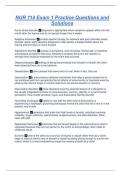NUR 114 Exam 1 Practice Questions and
Solutions
Acute stress disorder ✅diagnosis is appropriate when symptoms appear within the first
month after the trauma and do not persist longer than 4 weeks
Adaptive disclosure ✅combat-specific therapy for veterans with post-traumatic stress
disorder (ptsd); eight sessions designed to help identify unhelpful beliefs about the
trauma and find ways to move forward
Adjustment disorder ✅a group of symptoms, such as stress, feeling sad, or hopeless,
and physical symptoms that occur following a stressful life event; the reaction is
stronger than would be expected for the event that occurred
Depersonalization ✅feelings of being disconnected from himself or herself; the client
feels detached from his or her behavior
Derealization ✅client senses that events are not real, when in fact, they are
Dissociation ✅a subconscious defense mechanism that helps a person protect his or
her emotional self from recognizing the full effects of some horrific or traumatic event by
allowing the mind to forget or remove itself from the painful situation or memory
Dissociative disorders ✅these disorders have the essential feature of a disruption in
the usually integrated functions of consciousness, memory, identity, or environmental
perception; they include amnesia, fugue, and dissociative identity disorder
Grounding tecnhiques ✅helpful to use with the client who is dissociating or
experiencing a flashback; grounding techniques remind the client that he or she is in the
present, and is safe
Hyperarousal ✅symptoms that arise from high levels of anxiety, including insomnia,
irritability, anger outbursts, watchfulness, suspiciousness, and distrustfulness. Often
seen with ptsd
Repressed memories ✅memories that are buried deeply in the subconscious mind or
repressed because they are too painful for the victim to acknowledge; often relate to
childhood abuse
Survivor ✅view of the client as a survivor of trauma or abuse rather than as a victim;
helps to refocus client's view of himself or herself as being strong enough to survive the
ordeal, which is a more empowering image than seeing oneself as a victim
,Anergia ✅lack of energy
Anhedonia ✅having no pleasure or joy in life; losing any sense of pleasure from
activities formerly enjoyed
Electroconvulsive therapy (ect) ✅used to treat depression in select groups such as
clients who do not respond to antidepressants or those who experience intolerable
medication side effects at therapeutic doses
Euthymic ✅normal or level mood
Flight of ideas ✅excessive amount and rate of speech composed of fragmented or
unrelated ideas; racing, often unconnected, thoughts
Hypertensive crisis ✅a life-threatening condition that can result when a client taking
maois ingests tyramine-containing foods and fluids or other medications
Hypomania ✅a period of abnormally and persistently elevated, expansive, or irritable
mood lasting 4 days; does not impair the ability to function and does not involve
psychotic features
Kindling ✅the snowball-like effect seen when minor seizure activity seems to build up
into more frequent and severe seizures
Latency of response ✅refers to hesitation before the client responds to questions
Mania ✅a distinct period during which mood is abnormally and persistently elevated,
expansive, or irritable
Mood disorders ✅pervasive alterations in emotions that are manifested by depression
or mania or both
Pressured speech ✅unrelenting, rapid, often loud talking without pauses
Psychomotor agitation ✅increased body movements and thoughts
Psychomotor retardation ✅overall slowed movements; a general slowing of all
movements; slow cognitive processing and slow verbal interaction
Rumination ✅repeatedly going over the same thoughts
Seasonal affective disorder (sad) ✅mood disorder with two subtypes; in one, most
commonly called winter depression or fall-onset sad, people experience increased
sleep, appetite, and carbohydrate cravings; weight gain; interpersonal conflict; irritability;
, and heaviness in the extremities beginning in late autumn and abating in spring and
summer; the other subtype, called spring-onset sad, is less common and includes
symptoms of insomnia, weight loss, and poor appetite lasting from late spring or early
summer until early fall
Suicide precautions ✅removal of harmful items; increased supervision to prevent acts
of self-harm
Antisocial personality disorder ✅characterized by a pervasive pattern of disregard for,
or violation of, the rights of others that begins in childhood or early adolescence and
continues into adulthood.
Avoidant personality disorder ✅characterized by a pervasive pattern of social
discomfort and reticence, low self-esteem, and hypersensitivity to negative evaluation
Classified as an anxiety disorder, this is the term for an individual experiencing a
pervasive pattern of preoccupation with perfectionism, mental and interpersonal control,
and orderliness ✅ocd
This individual will present with repetitive thoughts and or behaviors that consume the
person. This disorder compels them to act out the behavior and often interferes with
their personal, social, and occupational function ✅ocd
Seen in ocd patients, repetitive behaviors or mental acts that the individual feels to
perform ✅compulsion
Seen in ocd patients, recurrent and persistent thoughts, urges, images, or impulses that
cause anxiety or distress ✅obsessions
Ocd commonly begins around this age in females ✅in the 20s
This anxiety disorder typically has an onset late in adolescence with periods coming and
going over a lifetime. It can start in childhood, especially in males ✅ocd
An ocd related disorder for skin picking ✅dermatillomania
An ocd related disorder for chronic, repetitive hair pulling ✅trichotillomania
An ocd related disorder for nail biting ✅onychophagia
An ocd related disorder for compulsive buying ✅oniomania
An ocd related disorder for excessive acquisition of animals or things ✅hoarding
disorder




